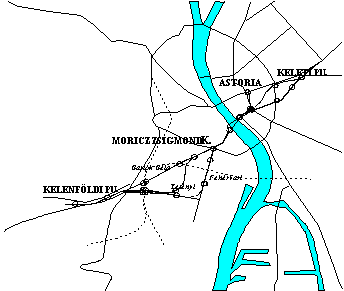|
|
||||||||||||||||||||||||||||||||||||||||||||||||||||||||||||||||||||||||||||||||||||||||||||||||||||||||||||||||||||||||||||||||||||||||||||||||||||||||||||||||||


BUDAPEST METRO LINE 4 FEASIBILITY STUDY Oktober 1996 |
 |
 |
SELECTION OF OPTIONS AND ALTERNATIVES |
|||||||||||||||||||||||||||||||||||||||||||||||||||||||||||||||||||||||||||||||||||||||||||||||||||||||||||||||||||||||||||||||||||||||||||||||||||||||||||||||
Introduction
This chapter describes the main options identified
and the possible alternatives within each. From this is derived
a long list of alternatives which are assessed in this section.
The purpose of the long list assessment is to produce a short
list for more detailed evaluation.
One of the objectives of Stage 1 of the study is
to establish ' the appropriate metro strategy to be adopted
in the second stage '. Lower cost transport options have
been identified in addition to a metro option, based on a significant
improvement in the level of service.
Definition and selection of the transport options
are based on 3 main families which were developed as follows:
The same concept of physical implementation (full segregation) supports the LRT and Metro options ; the LRT system in principle requires 'lighter' infrastructure, theoretically influencing the capital costs. Transport alternatives
Every transport option includes several technical
alternatives which are likely to have an influence upon the ridership,
the environmental impacts and the costs. They concern especially:
Transport sub-alternativesEvery alternative includes several sub-alternatives characterised by specific technical parameters. They are related more particularly to the infrastructure (partly or fully underground, depressed, at-grade or elevated), the construction methods, the rolling stock characteristics and other technical criteria. They have been mainly analysed during the engineering assessment described in Chapter 6, in terms of technical and operating feasibility and capital cost impacts. Main core of route for comparison and possible extensionsIn accordance with the Terms of Reference, the comparison of the metro and lower cost options is based on the principle of a new service linking Kelenföld Station to the CBD, constituting the 'main core' of the route. Further extensions are of course envisaged, especially towards Budaörs. They will be examined more in detail during Stage 2. Nevertheless, the Budaörs extension is analysed in broad terms of patronage, technical feasibility and costs. Transport options and alternatives analysedFor each of the three transport options defined above, a set of alternatives are analysed as follows: Option 1 : 'Surface' modes - Bus & Tram improvements
This option concerns the existing surface modes,
comprising bus and tram services. It assumes a significant improvement
of the level of service to make it nearly comparable to other
transport options in terms of capacity supplied. In order to
meet the demand a number of alternatives are identified which
are also complementary and are to be considered jointly, serving
the South West area and linking to Pest by crossing several bridges.
The alternatives are identified according to the
mode operated; bus or tram, as follows :
Alternatives 1.1 and 1.2 were in fact developed
to provide an understanding of the effect of improving individual
surface modes to help develop an overall surface mode improvement
alternative for inclusion in the short list.
Alternatives 1.1 and 1.2 are combined to complement each other resulting in alternative 1.3 (see Figure 5.1) for detailed analysis as a part of the short list assessment. Option 2 : LRT
|
||||||||||||||||||||||||||||||||||||||||||||||||||||||||||||||||||||||||||||||||||||||||||||||||||||||||||||||||||||||||||||||||||||||||||||||||||||||||||||||||||
| Option | Alternative | Sub-alternative | Characteristics | Figure ref. |
| 1 - Surface Mode improvements | ||||
| 1. | 1. | Bus family "7" | ||
| 1. | 2. | Tram lines 47 & 49 & 4 | ||
| 1. | 3. | Joint 1.1 & 1.2. | 5.1. | |
| 2 - LRT | 5.2. | |||
| Erzsébet bridge | ||||
| 2. | 1.1. | Bartók Béla | ||
| 2. | 1.2 | Fehérvári | ||
| Szabadság bridge | ||||
| 2. | 2.1 | a. | Over the bridge/Bartók Béla | |
| b. | Under the bridge/Bartók Béla | |||
| 2. | 2.2. | a. | Over the bridge/Fehérvári | |
| b. | Under the bridge/Fehérvári | |||
| 3 - Metro | 5.3. | |||
| Astoria | ||||
| 3. | 1.1. | Bartók Béla | ||
| 3. | 1.2. | Fehérvári | ||
| 3. | 1.3. | Tétényi | ||
| Blaha L./Keleti | ||||
| 3. | 2.1. | Bartók Béla | ||
| 3. | 2.2. | Fehérvári | ||
| 3. | 2.3. | Tétényi | ||
| Rákóczi/Keleti | ||||
| 3. | 3.1 | Bartók Béla | ||
| 3. | 3.2. | Fehérvári | ||
| 3. | 3.3. | Tétényi | ||
| 3. | 4. | Extension to the E-W line from Déli station. | ||

